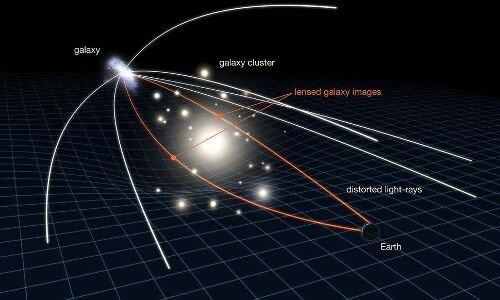Space Telescope sees ‘Einstein Zig-Zag’ for the first time: It thrilled

Science: Using the James Webb Space Telescope, astronomers have discovered the first “Einstein zig-zag,” an image of a quasar repeated six times in a single image. The arrangement was created by an effect called “gravitational lensing,” first proposed by Albert Einstein in 1915, and it could help scientists avert a crisis in cosmology.
The system, called J1721+8842, consists of a quasar — an extremely luminous galactic core — lensed by two widely separated, but perfectly aligned, galaxies. Not only is the sight incredibly rare, a fascinating example of a curious spacetime-bending phenomenon introduced into Albert Einstein’s great theory of gravity, general relativity, but the J1721+8842 zig-zag also has a power that standard gravitational lenses do not have.
The first Einstein zig-zag observed by humanity could help scientists tackle two of cosmology’s biggest mysteries. The first mystery relates to the nature of dark energy, or the force driving the accelerating expansion of the universe that accounts for about 70% of the cosmic energy and matter budget, and the second relates to an anomaly found by scientists when measuring the value of the universe’s expansion speed: the Hubble constant.
“I’m thrilled, not only because this is a fascinating natural phenomenon, but also because this system is incredibly promising for measuring cosmological parameters,” discovery team member and Stanford University cosmologist Martin Millan told Space.com. “This lens system provides the ability to put tight constraints on both the Hubble constant and the dark energy equation, which is not normally possible.”General relativity says that objects with mass create curvature in the very fabric of space and time, which are united as a single entity called “spacetime.” The greater the mass of an object, the greater the “dent” it will make in spacetime. Since gravity arises from this curvature, the more mass an object has, the greater its gravitational effect.
Gravitational lensing occurs when light from a background source passes through a massive lensing body on its way to Earth, and so follows the resulting curvature in space, causing its own path to curve. Light from this background source thus takes different paths around the gravitational lens, being curved by different amounts near the lensing mass at different distances. This means that this light from the same background source can arrive at the same telescope at different times.
As a result, the same background light-emitting body can appear in multiple places in the same image. These objects can form arrangements such as the Einstein ring, the Einstein cross, and, in this currently unique case, the Einstein zig-zag. The JWST was actually not the first telescope to find J1721+8842. The lensed quasar, a particularly bright patch of gas and dust surrounding a supermassive black hole, was observed by Cameron Leaman in 2017 using the Panoramic Survey Telescope and Rapid Response System (Pan-STARRS) located at the Haleakala Observatory in Hawaii.
At first, the quasar was only thought to be lensed four times. However, the sensitivity of the JWST revealed that two galaxies are actually lensing this distant quasar six times, with the more distant galaxy in this arrangement also being lensed by the closer galaxy.
“Typically, gravitational lenses produced by a single galaxy create two or four images of the background source, depending on the alignment. In this case, there is an exceptional alignment between two galaxies and a background quasar, creating a rare six-image configuration,” “That’s why we called it the ‘Einstein Zigzag’





